For most of the past decade, India’s public-sector stocks moved in a narrow range, weighed down by inconsistent earnings and muted investor interest. That phase quietly ended over the last three years. A combination of cleaner balance sheets, sharper capital allocation, and a clear policy push has turned the PSU basket into one of the strongest performers in the market. Yet as the rally broadened, a new question began to take shape among long-term investors: after such a steep re-rating, is there still meaningful value left in this space?
The answer isn’t straightforward. Some names have already exhausted their catch-up potential, but a few others are approaching an inflection point, driven by strong fundamentals, healthier order books, and visible earnings catalysts. This second wave of the PSU story is more about sustained profitability.
Against this backdrop, these four state-owned giants still stand out. They are trading below their respective industry multiple, signalling that their valuations retain a margin of safety even after the rally.
To begin with, here’s a snapshot on the 4 companies, and where they stand from a business perspective. Later on in the piece, we will dig into the valuations, and assess how deep value they really are.
#1 Bharat Electronics
Bharat Electronics (BEL) is a leading aerospace and defence electronics company that develops electronics technology solutions for the defence and civilian segments. Its primary focus is advanced electronics equipment, systems, and services for India’s defence sector.
The company’s core businesses involve supplying state-of-the-art products/systems to the Indian Armed Forces. Its portfolio includes Radars (such as Aslesha, Lynx series, Weapon Locating, and 3D Surveillance Radars), Missile systems (Akash, LRSAM, C4I), and Defence communication systems.
Strong defence pipeline guiding multi-year growth
The company is focused on self-reliance through indigenization. In FY25, turnover from indigenously developed products accounted for 74%. The company order book stood at ₹756 billion (as of 31 October 2025).
Further, the company expects to receive order inflows of ₹570 billion in FY26, taking the order book to around ₹1,300 billion. The order book provides revenue visibility of over 5 years, based on FY25 revenue of ₹237.7 billion.
Margin stability supported by indigenization
In terms of financials, revenue grew 15.9% year-on-year to ₹101.8 billion in the first half of FY26, driven by strong order book execution. EBITDA (earnings before interest, tax, depreciation, and amortization) margin expanded 289 basis points (bps) to 30.2%, leading to a 20.8% increase in profit after tax (PAT) to ₹18.7 billion.
Revenue is expected to grow more than 15% year-over-year in FY26, and EBITDA margins will remain similar. Management also expects these high margins to be maintained through cost optimization, indigenization, and operating efficiency.
Expanding beyond defence to diversify revenue
Looking ahead, to reduce its dependence on the defence business, BEL aims to grow its presence in allied defence and non-defence areas. The company aims to increase non-defence business revenue to about 20% of total turnover in the coming year, up from 5.7% in FY25. To this end, BEL plans to focus on exports to Southeast Asia, Europe, the Middle East, and Africa.
Bharat Electronics Share Price

#2 Hindustan Aeronautics
Hindustan Aeronautics (or HAL) primarily serves the Indian Armed Forces and is a strategic company in the aerospace, defence, and space industries. HAL’s integrated business includes research and development, manufacturing, maintenance, repair, and overhaul. HAL has expertise in executing Transfer of Technology projects like the Su-30MKI, Jaguar, and Hawk.
A Fighter Plane powerhouse
Repair and Overhaul is the largest segment, accounting for 70% of the turnover. In this segment, HAL repairs, overhauls, maintains, and upgrades aircraft, helicopters, engines, and accessories. This business is expected to remain strong and generate consistent revenue.
About 7% of revenue comes from design and development activities and exports. The company is known for manufacturing the LCA Tejas aircraft, the Advanced Light Helicopter, the Light Utility Helicopter, and the Dornier Do-228 aircraft. HAL also supplies engines for the Sukhoi fighter plane.
HAL also manufactures aerospace structures for the Indian Space Research Organization. It has supplied structural assemblies for missions such as the GSLV-F15 and NVS-02 missions. HAL also delivered the first gas generator module for the CE-20 cryogenic engine from its Integrated Cryogenic Manufacturing Facility.
Deep order visibility stretching through the next decade
From a financial perspective, revenue increased 10.9% year-on-year to ₹114.5 billion in the first half of FY26, driven by order book execution. However, EBITDA margin declined 390 bps to 23.5%, leading to a 13% decline in PAT to ₹25.5 billion. This performance was dragged down by a poor first quarter, when its PAT declined 4% to ₹13.8 billion.
As of 14 November 2025, HAL’s order book stood at ₹2.3 trillion, providing revenue visibility for over six years. Management says these orders are expected to keep its manufacturing lines busy until FY33.
The MoD has signed an ₹624 billion contract with HAL to procure 97 additional LCA Mk1A aircraft for the Indian Air Force. Deliveries are scheduled to commence in FY28 and conclude within six years. The order carries at least 64% indigenous content, with 67 additional locally sourced components compared to the previous contracts.
HAL has also entered into a USD 1b deal with GE Aerospace (USA) to supply 113 F404-GE engines. To meet the demand, HAL also completed the expansion of the Nashik production line in October 2025, increasing its annual LCA manufacturing capacity from 16 to 24 aircraft. The first Tejas Mk1A aircraft produced in HAL’s Nashik complex completed its maiden flight.
Capacity expansion to meet rising aircraft demand
The company plans to invest around ₹150 billion in capacity expansion over the next five years. This includes increasing the manufacturing capacity of LCA aircraft further to 30. HAL is also expanding its Helicopter production capacity from the current 30 Light Combat Helicopters (LCH) per annum at Tumakuru.
However, HAL acknowledges external threats, including increased competition arising from Ministry of Defence reforms such as the Defence Acquisition Procedure 2020, which promotes private participation and competitive procurement. Despite this, the ministry gives priority to Indigenously Designed, Developed, and Manufactured products.

#3 Garden Reach Shipbuilders
Garden Reach Shipbuilders (GRSE) is one of India’s premier shipbuilding companies. The company is the first shipyard in India to build warships for the Indian Navy and the Indian Coast Guard. Its primary business activities, encompassing Manufacturing and Service, account for 93.8% of its total turnover.
Where GRSE’s core strengths come from
GRSE also builds commercial ships and undertakes engineering and engine production activities. The company can build frigate-sized warships, but its strength lies in building smaller vessels for the Navy and Coast Guard. It has delivered 111 warships to the Indian Navy and Indian Coast Guard.
Additionally, as of 31 March 2025, GRSE had 40 vessels under construction. The company also develops critical naval technologies, such as the 30 mm Naval Surface Gun. GRSE also repairs ships from other countries, like Sri Lanka, the Maldives, Mauritius, and the Seychelles. However, the ship repair segment’s contribution to revenue is only 2.2%.
The engineering division focuses on diversification, accounting for 2.9% of revenue. The segment manufactures advanced products like portable bridges and specialized deck machinery. It actively works with organizations like the Border Road Organization and the National Highways and Infrastructure Development Corporation.
How the order book is building multi-year visibility
Looking ahead, management is confident the order book will cross ₹500 billion by the end of FY26, from ₹202 billion currently. This order book (if materialized) will provide a strong multi-year revenue potential of about 10 years. To this end, the company has been declared the lowest bidder (L1) for the Next Generation Corvette contract, worth ₹250 billion. This contract is expected to be signed within the next 3-4 months.
GRSE also anticipates that if the P7 Bravo contract is secured, the order book could increase by upwards of ₹750 billion within the next 15 to 18 months. While the long-term outlook remains strong, management is also confident of strong near-term growth.
The company sees massive future opportunities, too. Seven high-value projects have been accorded the Approval of Necessity by the DAC, totalling about ₹1.5 trillion. This includes the P7 Bravo project (₹700 billion), for which the Request for Proposal (RFP) is expected in Q4 of FY26, Mine Countermeasure Vessels (₹320 billion), and Landing Platform Docks (₹350 billion).
New opportunities in commercial and export shipbuilding
GRSE plans to enter the competitive commercial shipbuilding sector to meet both domestic and global demands. Targeted non-defence products include ocean ferries (cargo + passenger), multi-purpose vessels, tugs, dredgers, barges and e-ferries. It is also actively pursuing avenues to expand its geostrategic reach for the export of defence and commercial ships.
To this end, it already achieved a breakthrough by securing export orders for the construction of eight Multi-Purpose Vessels for a German client ($108 million). This gives GRSE a foothold in the competitive European short sea shipping market.
Expansion plans that could redefine capacity by 2028
GRSE also has ambitious expansion plans. The company has envisioned establishing a state-of-the-art greenfield shipyard outside Kolkata by 2028 to enhance in-house capacity. It also plans to strengthen the refit and repair business vertical by actively targeting orders from the Indian Navy, Indian Coast Guard, Ministry of Home Affairs, and state governments.
The company is also building prototypes for Autonomous Vessels and widening its footprint in green vessels, such as the ‘Dheu’ fully electric ferry. This has led to subsequent orders for 13 hybrid ferries from the Government of West Bengal. The company is also working on Hydrogen Fuel Cell Ferry designs and Hybrid Tugs aligned with the Green Tug Transition Plan.
From a financial perspective, revenue increased 38% year-on-year to ₹29.8 billion in the first half of FY26. Net profit surged 48% to ₹2.7 billion, as operating margin expanded by 300 basis points to 9%. The growth exceeded the company’s own guidance and its historical growth rate of about 30%.

#4 National Thermal Power Corporation
National Thermal Power Corporation (NTPC) core business is the generation and sale of bulk power to State Power Utilities. Power generation accounted for 97.62% of the company’s turnover in FY25, with coal-based generation comprising 92.83% of service turnover. NTPC is crucial to India’s energy security.
As of 31 March 2025, the total capacity of ongoing projects is 33.7 gigawatt (GW). It is aggressively focusing on renewable energy, with 13.8 GW of ongoing Renewable Projects under Joint Ventures & Subsidiaries. NTPC is also expanding its footprint through the acquisition of thermal power plants, like the Mahagenco (1.3 GW) plant in Nashik, from NCLT.
Renewable and nuclear bets reshaping the growth mix
NTPC has also signed strategic MoUs to explore opportunities in renewable energy, energy storage solutions, and the commercialization of green hydrogen, green ammonia, and green methanol, including an MoU with GAIL in February 2025. The company is also diversifying into Battery Energy Storage Systems, with plans to add about 5.0 GW of battery capacity co-located with thermal projects and 5.0 GW with solar.
Strategic expansions enhancing long-term visibility.
The company is expected to benefit from sustained growth in power demand. Emerging new-age demand accelerators, particularly giga-scale data centres, are anticipated to propel power demand multi-fold in the years to come. The company expects to expand its renewable energy capacity to 60 GW by FY32 and 130-140 GW by FY37.
It’s also expected to be a key beneficiary of Nuclear Energy. The government has approved the transfer of the Mahi Banswara Rajasthan Atomic Power Project (MBRAPP, 4 x 700 MW) to the Joint Venture Company, Anushakti Vidhyut Nigam. NTPC Parmanu Urja Nigam will oversee the nuclear business.
From a financial perspective, the company’s standalone total income declined 2.6% year-on-year to ₹840 billion in H1 FY26. However, PAT rose by 2.9% to ₹94.3 billion, driven by operational gains, and the average cost of borrowings fell.

Valuation at a Discount to Industry
From a valuation perspective, each company trades below its industry P/E, suggesting that, relatively speaking, these companies are trading at a discount to their peer group. At the same time, all of them quote above their own 5-year median P/E, which reflects the sharp re-rating that has played out over the last three years.
The defence names draw additional support from their strong order books and steady order pipelines, which provide visibility well beyond FY26. This depth not only strengthens earnings confidence but also helps justify the higher multiples the market is now willing to assign.
Given this, it is fair to say that while these four PSUs have delivered a solid performance over the last few years, they have yet to catch up with their private-sector peers. Now, whether they can reduce the gap, only time will tell.
Valuation Comparison (X)
| Company | P/E | 5-Year Median | Industry P/E |
| BEL | 54.0 | 29.1 | 67.4 |
| HAL | 37.9 | 17.5 | |
| GRSE | 53.1 | 26.4 | |
| NTPC | 13.4 | 10.1 | 27.3 |
Disclaimer
Note: Throughout this article, we have relied on data from http://www.Screener.in and the company’s investor presentation. Only in cases where the data was not available have we used an alternate but widely used and accepted source of information.
The purpose of this article is only to share interesting charts, data points, and thought-provoking opinions. It is NOT a recommendation. If you wish to consider an investment, you are strongly advised to consult your advisor. This article is strictly for educational purposes only.
About the Author: Madhvendra has been deeply immersed in the equity markets for over seven years, combining his passion for investing with his expertise in financial writing. With a knack for simplifying complex concepts, he enjoys sharing his honest perspectives on startups, listed Indian companies, and macroeconomic trends.
A dedicated reader and storyteller, Madhvendra thrives on uncovering insights that inspire his audience to deepen their understanding of the financial world.
Disclosure: The writer and his dependents do not hold the stocks discussed in this article.
The website managers, its employee(s), and contributors/writers/authors of articles have or may have an outstanding buy or sell position or holding in the securities, options on securities or other related investments of issuers and/or companies discussed therein. The articles’ content and data interpretation are solely the personal views of the contributors/ writers/authors. Investors must make their own investment decisions based on their specific objectives, resources, and only after consulting such independent advisors as may be necessary.

